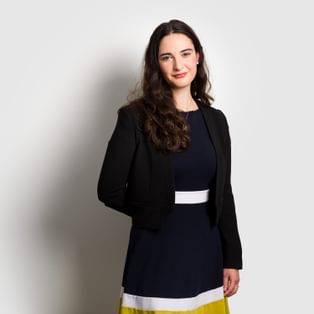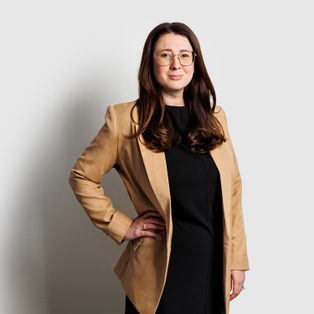Are apples different from pears? Or are they both just fruit? Or, as cockney rhyming slang would have it, are they stairs? These are the questions (excepting the last one) that the distinguished judges of the Court of Justice of the European Communities (CJEU) have been gr-apple-ing with in the recent case of Pear Technologies v EUIPO – Apple [2019] EUECJ T-215/17. Aside from offering opportunities for highly amusing wordplay, this recent decision includes some useful guidance on the CJEU’s approach to the visual and conceptual comparison of signs in trade mark disputes.
The case is the result of an EU logo trade mark application (see below) by digital marketing company Pear Technologies Ltd (PTL) in 2014. The application, which was in three classes (9 (computer software), 35 (consultancy services) and 42 (computer services)), was opposed by Apple Inc. (Apple) before the European Intellectual Property Office (EUIPO). Apple based its opposition on its prior EU registration for the well-known apple logo (see below).
Apple’s opposition was upheld by the EUIPO in early 2016 on the basis of what is now Article 8(5) of Regulation (EU) 2017/1001. In broad terms, this provision entitles the owner of an earlier trade mark “with a reputation” to prevent the registration and/or use of a later mark which is “identical and/or similar”. In order to engage Article 8(5)’s prohibition, the use of the later mark must “without due cause…take unfair advantage of, or be detrimental to, the distinctive character or repute of the earlier mark”.
PTL appealed, but this was rejected by the EUIPO Board of Appeal with a finding that there was “at most visual similarity and a weak conceptual similarity between the marks at issue”. The finding of a visual similarity was based on the fact that marks both “depicted sleek rounded silhouettes of fruit, with the oblong shape leaning to the right on top of the main object, and secondly, corresponded to stylised solid images of a fruit with its characteristic stem”. Conceptually, the Board of Appeal found that, “although apples and pears are two distinguishable fruits, they are fruits which are closely related in a biological sense (origin, size, colours, texture) and they are associated together in many ways…and are common alternatives to each other”. While admitting that this finding of similarity involved the consumer “making some mental steps”, the Board of Appeal concluded that “because of the uniqueness and the high reputation of the earlier mark, the allusive and ‘somewhat mocking’ image of the pear depicted in the mark applied for would establish a mental link with the earlier mark”.
PTL appealed again, this time to the CJEU. In a sometimes bemused-sounding judgment, the CJEU found that the Board of Appeal was wrong to conclude that there was, visually and conceptually, a low degree of similarity between the two marks.
On the visual comparison, the CJEU, noted that:
- the PTL mark comprised a “large number of squares with curved edges of black colour” which combined “only to form the image of a pear in the mind of the observer”. This contrasted with the Apple mark, which would be viewed as “an apple, with a bite taken out of it, with a leaf sitting on top”;
- the PTL mark included the word “PEAR” written below the image. The Board of Appeal had wrongly dismissed this as negligible in the context of the image above it; this text, in fact, contributed “significantly to determining the image of the mark”; and
- while the positioning of the stem or leaf elements were at a similar angle, “the concrete shape and size of those elements [were] very different”.
From a conceptual perspective, the CJEU found that there were “clear differences between the concepts conveyed by the two marks”. Put glibly, one was an apple, and the other was a pear. The CJEU did elaborate, however, noting that:
- the PTL mark did not share the concept of a “fruit with bite taken out of it”; instead, it evoked “the idea of a full pear”;
- the PTL mark evoked the concept of a “pear with a stem”, rather than an apple with a “leaf sitting on top”;
- while both marks could be described as “fruit”, it was inconceivable that the relevant public would use that term instead of the more specific “apple” or “pear”;
- while pears and apples are fruits with shared characteristics, the Board of Appeal was wrong to give that factor decisive importance in the context of the conceptual comparison, as these factors were “not depicted in the conflicting marks themselves, but require[d] an abstract analysis and prior knowledge on the part of the relevant public”. The CJEU added later that the fact that “pears and apples belong to the same plant family Rosaceae and the same sub-family pomoideae” was unlikely to be known by the relevant public; and
- “in several European Union languages, apples and pears are used in proverbs to illustrate that two things are different and not comparable”.
The CJEU’s decision will be welcomed by many as showing good sense. By the same token, however, it is perhaps concerning that PTL had to pursue the matter to such an advanced stage before prevailing. Aside from the criticism of the Board of Appeal’s decision, the CJEU identified technical flaws in the Board’s reasoning, suggesting that Apple may have succeeded in blinding it with technical arguments and evidence, and leading the Board of Appeal to lose sight of the “overall comparison” of signs that is required. Most brand owners will not have the resources or time to take cases to such an advanced stage. However, based on PTL’s experience, anyone wishing to sail close to the wind with their choice of mark may need to take a gamble on costs.



























































































